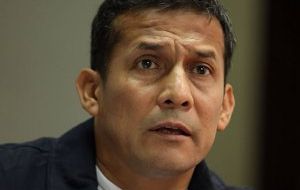MercoPress. South Atlantic News Agency
Peruvian government fights anti-Xstrata mine protestors: 2 dead and 50 injured
 President Humala, a former military office has become impatient with intransigent protesters
President Humala, a former military office has become impatient with intransigent protesters Two people were killed and 50 were injured in protests against Xstrata's Peruvian copper mine Tintaya on Monday, prompting the government to suspend freedom of assembly in a bid to break roadblocks isolating the mine.
At least 30 of the injured were police and one judicial official was detained by protesters in the mountainous southern region of Cusco, officials said.
President Ollanta Humala, a former military officer like Prime Minister Oscar Valdes, has urged mediation to avert violence, but critics say he has become impatient with intransigent protesters and too willing to rely on authoritarian tactics to maintain order.
The latest protest over the spoils of natural resource wealth is one of hundreds of disputes that Humala has tried to defuse. The conflicts threaten to delay billions of dollars in investments in a sector that drives 60% of exports in Peru's fast-growing economy. They also test Humala's ability to resolve conflicts in an often polarized political environment.
“What we are dealing with isn't a peaceful protest. We are dealing with extremists,” Valdes said in a nationwide TV address.
It was at least the second time the Humala administration has used emergency rules that give the army special police powers and prohibit people from gathering in groups to end anti-mining protests in one of the world's leading minerals exporters.
At least 10 people have died in disputes over natural resources since Humala took office in July. At least 174 people died in similar protests during the government of his predecessor, Alan Garcia - marring his term.
The Tintaya protest has blocked transport links, but the global firm's mine is operating normally and its port on the Pacific coast has stocks of concentrates for the time being, a company executive said.
Despite being hit by the week-long protest, Xstrata is committed to investing in Peru and its 1.5 billion dollars expansion to the Tintaya mine is on track to open in late August, said Luis Rivera, the company's operations director for Peru.
Protesters in the province of Espinar say the mine causes pollution and want the company to boost financial donations it makes to the local government of Espinar, which the company has rejected, saying its voluntary contributions are already very generous.
”Our local contribution is 30 million soles (11 million dollars) a year, which isn't a little,“ Rivera said. ”We give 3% of our pre-tax profits to the province of Espinar and they want us to raise this to 30%“
Espinar, like many local and regional governments in Peru, is periodically hit by anti-mining protests by poor residents who say they have not seen the benefits of the country's decade-long economic boom. The central government and miners criticize local governments for lacking the capacity to spend tax revenue and say they are sitting on piles of cash.
”The municipal budget in Espinar is 190 million soles a year, and it only manages to spend 30 percent, and they are asking for more money,“ Rivera said.
He said all serious studies have shown the mine fully complies with all environmental standards and that complaints of the protesters over water quality were being trumped up for political reasons.
”There is a radical political position behind all of this,” Rivera said.
Humala, a former leftist who now firmly supports projects proposed by foreign mining companies, has said the far-left, while small, has tried to stop big mining projects as part of a push to expand its influence.
Protests against the $4.8 billion Conga mine in northern Peru, the largest project in the history of the country, have already delayed U.S.-based Newmont Mining's (NEM.N) timetable for the mine.
“We are interested in dialogue and the development of Espinar, but we find ourselves facing a very radical opposition,” Mines and Energy Minister Jorge Merino said in a statement from his office.
“There is a radical current that says no to Antapaccay and no to Las Bambas. This means they don't want mining, which is unacceptable,” the minister said.
Rivera said the company's Antapaccay copper project, which is essentially an expansion of Tintaya that would almost double capacity to 160,000 tonnes a year, is on track to open in late August.
The existing part of Tintaya is slated to end operations in 2014 and Antapaccay would stay open to 2030 or beyond. Tintaya currently produces about 90,000 tonnes a year of copper.
Xstrata is also working on its 4.2 billion dollars Las Bambas project in southern Peru. It would produce an average of 400,000 tonnes of copper concentrate plus gold, silver and molybdenum by-products. The company's website says it would open by the end of 2014.




Top Comments
Disclaimer & comment rulesCommenting for this story is now closed.
If you have a Facebook account, become a fan and comment on our Facebook Page!